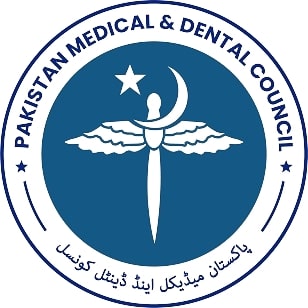EVALUATION OF DIAGNOSTIC VALIDITY OF PIVKA-II FOR DIAGNOSIS OF HEPATOCELLULAR CARCINOMA IN PATIENTS OF CIRRHOSIS WITH LIVER NODULES PRESENTED IN A TERTIARY CARE HOSPITAL OF LAHORE
DOI:
https://doi.org/10.59058/jaimc.v20i2.37Keywords:
HCC, liver nodules, cirrhosis, PIVKA-II and AFP.Abstract
Objectives: To evaluate the diagnostic validity of PIVKA-II for Hepatocellular carcinoma in cirrhotic patients with uncertain liver nodules on Ultrasound.
Methods: This was a cross-sectional study conducted in 01-11-2020 and 31-12-2021 at Hepatitis clinic at Jinnah Hospital Lahore. Patients who fulfilled the selection criteria(n=100) were enlisted for this study. Blood samples were obtained to test for PVKA-11 and AFP in cirrhotic patients who had liver nodules that had been previously verified by ultrasound imaging. Data were entered and analyzed in SPSS ver: 21.0. Sensitivity, specificity and predictive values were calculated using CT imaging and biopsy as gold standard. ROC curve evaluating AFP, PIVKA-II, and a combination as indicators for Hepatocellular carcinoma at 95% Confidence Interval was calculated with a p < .05 value was taken as statistical significant.
Results: HCC was confirmed in 45 of the 100 instances, and it was invariably at an early or very early stage. At a threshold of 62.5 mAU/mL, PIVKA-II and HCC were significantly correlated (P =.015 and P =.036, respectively) in univariate and multivariate analyses. For AFP, 7.5 ng/mL was the ideal cut-off. For PIVKA- II, sensitivity was 62% and specificity was 91% , while for AFP, they are 66% and 69% respectively. The positive and negative predictive values for PIVKA-II were 81% and 74%, respectively, while for AFP sensitivity was 63% and specificity was 72%. The combination of both biomarkers improved the precision of diagnosing HCC (sensitivity = 74%, specificity = 95.5%, NPV = 81%, PPV = 92%, and AUC = 0.781).
Conclusion: PIVKA-II is a valid indicator for defining the characteristics of liver nodules in cirrhosis and when combined with AFP, it signifies superior accuracy for HCC diagnosis.
References
Ferlay J, Soerjomataram I, Dikshit R. Cancer Incidence and mortality worldwide: sources, methods and major patterns in GLOBO- CAN 2012. Int J Cancer 2015;136:E359–86.
El-Serag HB. Hepatocellular carcinoma. N Engl J Med 2011;365: 1118–27.
Llovet JM, Burroughs A, Bruix J. Hepatocellular carcinoma. Lancet 2003;362:1907–17.
Bruix J, Sherman M. Management of hepatocellular carcinoma: an update. Hepatology 2011;53:1020–2.
Marrero JA, Su GL, Wei W.Des-gamma carboxyprothrombin can differentiate hepatocellular carcinoma from nonmalignant chronic liver disease in american patients. Hepatology 2003;37:1114–21.
Durazo FA, Blatt LM, Corey WG.Des-gamma- carboxyprothrom- bin, alpha-fetoprotein and AFP- L3 in patients with chronic hepatitis, cirrhosis and hepatocellular carcinoma. J Gastroenterol Hepatol 2008; 23:1541–8.
Singal A, Volk ML, Waljee A. Meta-analysis: surveillance with ultrasound for early-stage hepatocellular carcinoma in patients with c i r r h o s i s . A l i m e n t P h a r m a c o l T h e r 2009;30:37–47.
Liaw YF, Tai DI, Chen TJ. Alpha-fetoprotein changes in the course of chronic hepatitis: relation to bridging hepatic necrosis and hepatocellular carcinoma. Liver 1986;6:133–7.
Chang YC, Nagasue N, Abe S. Alpha Fetoprotein producing early gastric cancer with liver metastasis: report of three cases. Gut 1991;32:542–5.
Marrero JA, Su GL, Wei W, et al. Des-gamma carboxyprothrombin can differentiate hepatocellular carcinoma from nonmalignant chronic liver disease in American patients. Hepatology 2003;37:1114–21.
de Lope CR, Tremosini S, Forner A.Management of HCC. J Hepatol 2012;56:S75–87.
Baek YK, Lee JH, Jang JS, et al. Diagnostic role and correlation with staging systems of PIVKA-II compared with AFP. Hepatogastroenterology 2009;56:763–7.
Kokudo N, Hasegawa K, Akahane M. Evidence- based Clinical Practice Guidelines for Hepatocellular Carcinoma: The Japan Society ofHepatology 2013 update (3rd JSH-HCC Guidelines). Hepatol Res 2015;45:123–7.
Lok AS, Sterling RK, Everhart JE, et al. Des- gamma-carboxyprothrom- bin and alpha- fetoprotein as biomarkers for the early detection of hepatocellular carcinoma. Gastroenterology 2010;138:493–502.
Poté N, Cauchy F, Albuquerque M, et al.Performance of PIVKA- I I for early hepatocellular carcinoma diagnosis and prediction of microvascu- lar invasion. J Hepatol 2015;62:848–54.
Caviglia GP, Abate ML, Petrini E, et al. Highly sensitive alpha- fetoprotein, Lens culinaris agglutinin-reactive fraction of alpha-fetopro- tein and des-gamma-carboxyprothrombin for hepatocellular carcinoma detection. Hepatol Res 2016;46:E130–5.
Omata M, Lesmana LA, Tateishi R, et al. Asian Pacific Association for the Study of the Liver consensus recommendations on hepatocellular carcinoma. Hepatol Int 2010;4:439–74.
Ertle JM, Heider D, Wichert M, et al. A combination of a-fetoprotein and des-g-carboxy prothrombin is superior in detection of h e p a t o c e l l u l a r c a r c i n o m a . D i g e s t i o n 2013;87:121–31.
Downloads
Published
How to Cite
Issue
Section
License
Copyright (c) 2023 JAIMC

This work is licensed under a Creative Commons Attribution 4.0 International License.
The articles published in this journal come under creative commons licence Attribution 4.0 International (CC BY 4.0) which allows to copy and redistribute the material in any medium or format Adapt — remix, transform, and build upon the material for any purpose, even commercially under following terms.
-
Attribution — You must give appropriate credit, provide a link to the license, and indicate if changes were made. You may do so in any reasonable manner, but not in any way that suggests the licensor endorses you or your use.
- No additional restrictions — You may not apply legal terms or technological measures that legally restrict others from doing anything the license permits.
The editorial board of the Journal strives hard for the authenticity and accuracy of the material published in the Journal. However, findings and statements are views of the authors and do not necessarily represent views of the Editorial Board. Many software like (Google Maps, Google Earth, Biorender (free version)) restricts the free distribution of materials prepared using these softwares. Therefore, authors are strongly advised to check the license/copyright information of the software used to prepare maps/images. In case of publication of copyright material, the correction will be published in one of the subsequent issues of the Journal, and the authors will bear the printing cost.










